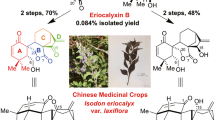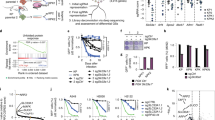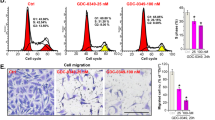Abstract
The Kelch-like ECH-associated protein 1 (KEAP1)–nuclear factor E2-related factor 2 (NRF2)pathway has a central role in cellular antioxidant defense. NRF2 activation due to KEAP1 or NRF2 mutations occurs frequently in many cancers, suggesting that NRF2 inhibition could be a promising therapeutic strategy. However, no potent NRF2 inhibitors are clinically available to date. To develop potent NRF2 inhibitors for therapeutic purpose, we screened ~4000 clinical compounds and determined clobetasol propionate (CP) as the most potent NRF2 inhibitor. Mechanistically, CP prevented nuclear accumulation and promoted β-TrCP-dependent degradation of NRF2 in a glucocorticoid receptor- and a glycogen synthase kinase 3 (GSK3)-dependent manner. As a result, CP induced oxidative stress and strongly suppressed the anchorage-independent growth of tumors with KEAP1 mutation, but not with the wild-type KEAP1. Further, CP alone or in combination with rapamycin strongly inhibited the in vitro and in vivo growth of tumors harboring mutations in KEAP1 or both KEAP1 and LKB1 that are frequently observed in lung cancer. Thus, CP could be a repurposed therapeutic agent for cancers with high NRF2 activity. We also proposed that the use CP and rapamycin in combination could be a potential therapeutic strategy for tumors harboring both KEAP1 and LKB1 mutations.
This is a preview of subscription content, access via your institution
Access options
Subscribe to this journal
Receive 50 print issues and online access
$259.00 per year
only $5.18 per issue
Buy this article
- Purchase on Springer Link
- Instant access to full article PDF
Prices may be subject to local taxes which are calculated during checkout







Similar content being viewed by others
References
Suzuki T, Yamamoto M . Molecular basis of the Keap1–Nrf2 system. Free Radic Biol Med 2015; 88 (Part B): 93–100.
Gorrini C, Harris IS, Mak TW . Modulation of oxidative stress as an anticancer strategy. Nat Rev Drug Discov 2013; 12: 931–947.
Ramos-Gomez M, Dolan PM, Itoh K, Yamamoto M, Kensler TW . Interactive effects of nrf2 genotype and oltipraz on benzo[a]pyrene–DNA adducts and tumor yield in mice. Carcinogenesis 2003; 24: 461–467.
Sharma S, Gao P, Steele VE . The chemopreventive efficacy of inhaled oltipraz particulates in the B[a]P-induced A/J mouse lung adenoma model. Carcinogenesis 2006; 27: 1721–1727.
Lu M-C, Ji J-A, Jiang Z-Y, You Q-D . The Keap1–Nrf2–ARE pathway as a potential preventive and therapeutic target: an update. Med Res Rev 2016; 36: 924–963.
Sporn MB, Liby KT . NRF2 and cancer: the good, the bad and the importance of context. Nat Rev Cancer 2012; 12: 564–571.
Menegon S, Columbano A, Giordano S . The dual roles of NRF2 in cancer. Trends Mol Med 2016; 22: 578–593.
Jaramillo MC, Zhang DD . The emerging role of the Nrf2–Keap1 signaling pathway in cancer. Genes Dev 2013; 27: 2179–2191.
Leinonen Hanna M, Kansanen E, Pölönen P, Heinäniemi M, Levonen A-L . Dysregulation of the Keap1–Nrf2 pathway in cancer. Biochem Soc Trans 2015; 43: 645–649.
Cancer Genome Atlas Research N. Comprehensive molecular profiling of lung adenocarcinoma. Nature 2014; 511: 543–550.
Cancer Genome Atlas Research N. Comprehensive genomic characterization of squamous cell lung cancers. Nature 2012; 489: 519–525.
Inami Y, Waguri S, Sakamoto A, Kouno T, Nakada K, Hino O et al. Persistent activation of Nrf2 through p62 in hepatocellular carcinoma cells. J Cell Biol 2011; 193: 275–284.
Umemura A, He F, Taniguchi K, Nakagawa H, Yamachika S, Font-Burgada J et al. p62, upregulated during preneoplasia, induces hepatocellular carcinogenesis by maintaining survival of stressed HCC-initiating cells. Cancer Cell 2016; 29: 935–948.
Guo Y, Yu S, Zhang C, Kong A-NT . Epigenetic regulation of Keap1-Nrf2 signaling. Free Radic Biol Med 2015; 88 (Part B): 337–349.
DeNicola GM, Karreth FA, Humpton TJ, Gopinathan A, Wei C, Frese K et al. Oncogene-induced Nrf2 transcription promotes ROS detoxification and tumorigenesis. Nature 2011; 475: 106–109.
Tao S, Wang S, Moghaddam SJ, Ooi A, Chapman E, Wong PK et al. Oncogenic KRAS confers chemoresistance by upregulating NRF2. Cancer Res 2014; 74: 7430–7441.
Ren D, Villeneuve NF, Jiang T, Wu T, Lau A, Toppin HA et al. Brusatol enhances the efficacy of chemotherapy by inhibiting the Nrf2-mediated defense mechanism. Proc Natl Acad Sci USA 2011; 108: 1433–1438.
Olayanju A, Copple IM, Bryan HK, Edge GT, Sison RL, Wong MW et al. Brusatol provokes a rapid and transient inhibition of Nrf2 signaling and sensitizes mammalian cells to chemical toxicity—implications for therapeutic targeting of Nrf2. Free Radic Biol Med 2015; 78: 202–212.
Tang X, Wang H, Fan L, Wu X, Xin A, Ren H et al. Luteolin inhibits Nrf2 leading to negative regulation of the Nrf2/ARE pathway and sensitization of human lung carcinoma A549 cells to therapeutic drugs. Free Radic Biol Med 2011; 50: 1599–1609.
Zhang Y-C, Gan F-F, Shelar SB, Ng K-Y, Chew E-H . Antioxidant and Nrf2 inducing activities of luteolin, a flavonoid constituent in Ixeris sonchifolia Hance, provide neuroprotective effects against ischemia-induced cellular injury. Food Chem Toxicol 2013; 59: 272–280.
Arlt A, Sebens S, Krebs S, Geismann C, Grossmann M, Kruse ML et al. Inhibition of the Nrf2 transcription factor by the alkaloid trigonelline renders pancreatic cancer cells more susceptible to apoptosis through decreased proteasomal gene expression and proteasome activity. Oncogene 2013; 32: 4825–4835.
Wang XJ, Hayes JD, Henderson CJ, Wolf CR . Identification of retinoic acid as an inhibitor of transcription factor Nrf2 through activation of retinoic acid receptor alpha. Proc Natl Acad Sci USA 2007; 104: 19589–19594.
Tan KP, Kosuge K, Yang M, Ito S . NRF2 as a determinant of cellular resistance in retinoic acid cytotoxicity. Free Radic Biol Med 2008; 45: 1663–1673.
Kaufman JM, Amann JM, Park K, Arasada RR, Li H, Shyr Y et al. LKB1 loss induces characteristic patterns of gene expression in human tumors associated with NRF2 activation and attenuation of PI3K-AKT. J Thorac Oncol 2014; 9: 794–804.
Skoulidis F, Byers LA, Diao L, Papadimitrakopoulou VA, Tong P, Izzo J et al. Co-occurring genomic alterations define major subsets of KRAS-mutant lung adenocarcinoma with distinct biology, immune profiles, and therapeutic vulnerabilities. Cancer Discov 2015; 5: 860–877.
Kadmiel M, Cidlowski JA . Glucocorticoid receptor signaling in health and disease. Trends Pharmacol Sci 2013; 34: 518–530.
Cuadrado A . Structural and functional characterization of Nrf2 degradation by glycogen synthase kinase 3/β-TrCP. Free Radic Biol Med 2015; 88 (Part B): 147–157.
Chowdhry S, Zhang Y, McMahon M, Sutherland C, Cuadrado A, Hayes JD . Nrf2 is controlled by two distinct beta-TrCP recognition motifs in its Neh6 domain, one of which can be modulated by GSK-3 activity. Oncogene 2013; 32: 3765–3781.
Rada P, Rojo AI, Chowdhry S, McMahon M, Hayes JD, Cuadrado A . SCF/{beta}-TrCP promotes glycogen synthase kinase 3-dependent degradation of the Nrf2 transcription factor in a Keap1-independent manner. Mol Cell Biol 2011; 31: 1121–1133.
Salazar M, Rojo AI, Velasco D, de Sagarra RM, Cuadrado A . Glycogen synthase kinase-3β inhibits the xenobiotic and antioxidant cell response by direct phosphorylation and nuclear exclusion of the transcription factor Nrf2. J Biol Chem 2006; 281: 14841–14851.
Ference JD, Last AR . Choosing topical corticosteroids. Am Fam Physician 2009; 79: 135–140.
Jacob SE, Steele T . Corticosteroid classes: a quick reference guide including patch test substances and cross-reactivity. J Am Acad Dermatol 2006; 54: 723–727.
Singh A, Misra V, Thimmulappa RK, Lee H, Ames S, Hoque MO et al. Dysfunctional KEAP1–NRF2 Interaction in Non-Small-Cell Lung Cancer. PLoS Med 2006; 3: e420.
Hast BE, Cloer EW, Goldfarb D, Li H, Siesser PF, Yan F et al. Cancer-derived mutations in KEAP1 impair NRF2 degradation but not ubiquitination. Cancer Res 2014; 74: 808–817.
Sanchez-Cespedes M . A role for LKB1 gene in human cancer beyond the Peutz-Jeghers syndrome. Oncogene 2007; 26: 7825–7832.
Zhong D, Guo L, de Aguirre I, Liu X, Lamb N, Sun S-Y et al. <em>LKB1</em> mutation in large cell carcinoma of the lung. Lung Cancer 53: 285–294.
Shaw RJ, Bardeesy N, Manning BD, Lopez L, Kosmatka M, DePinho RA et al. The LKB1 tumor suppressor negatively regulates mTOR signaling. Cancer Cell 2004; 6: 91–99.
Shaw RJ . LKB1 and AMPK control of mTOR signalling and growth. Acta Physiol (Oxford, England) 2009; 196: 65–80.
Faubert B, Vincent EE, Griss T, Samborska B, Izreig S, Svensson RU et al. Loss of the tumor suppressor LKB1 promotes metabolic reprogramming of cancer cells via HIF-1α. Proc Natl Acad Sci USA 2014; 111: 2554–2559.
Gao Y, Xiao Q, Ma H, Li L, Liu J, Feng Y et al. LKB1 inhibits lung cancer progression through lysyl oxidase and extracellular matrix remodeling. Proc Natl Acad Sci USA 2010; 107: 18892–18897.
Scagliotti GV, Selvaggi G . Antimetabolites and cancer: emerging data with a focus on antifolates. Expert Opin Ther Pat 2006; 16: 189–200.
Slingerland M, Cerella C, Guchelaar HJ, Diederich M, Gelderblom H . Cardiac glycosides in cancer therapy: from preclinical investigations towards clinical trials. Invest New Drugs 2013; 31: 1087–1094.
Kim N, Yim HY, He N, Lee C-J, Kim JH, Choi J-S et al. Cardiac glycosides display selective efficacy for STK11 mutant lung cancer. Sci Rep 2016; 6: 29721.
Calderon-Montano JM, Burgos-Moron E, Orta ML, Maldonado-Navas D, Garcia-Dominguez I, Lopez-Lazaro M . Evaluating the cancer therapeutic potential of cardiac glycosides. Biomed Res Int 2014; 2014: 794930.
Calderon-Montano JM, Burgos-Moron E, Lopez-Lazaro M . The in vivo antitumor activity of cardiac glycosides in mice xenografted with human cancer cells is probably an experimental artifact. Oncogene 2014; 33: 2947–2948.
Moghadam-Kia S, Werth VP . Prevention and treatment of systemic glucocorticoid side effects. Int J Dermatol 2010; 49: 239–248.
Lin K-T, Wang L-H . New dimension of glucocorticoids in cancer treatment. Steroids 2016; 111: 84–88.
Spokoini R, Kfir-Erenfeld S, Yefenof E, Sionov RV . Glycogen synthase kinase-3 plays a central role in mediating glucocorticoid-induced apoptosis. Mol Endocrinol 2010; 24: 1136–1150.
Sundahl N, Bridelance J, Libert C, De Bosscher K, Beck IM . Selective glucocorticoid receptor modulation: new directions with non-steroidal scaffolds. Pharmacol Ther 2015; 152: 28–41.
Ki SH, Cho IJ, Choi DW, Kim SG . Glucocorticoid receptor (GR)-associated SMRT binding to C/EBPβ TAD and Nrf2 Neh4/5: role of SMRT recruited to GR in GSTA2 gene repression. Mol Cell Biol 2005; 25: 4150–4165.
Kratschmar DV, Calabrese D, Walsh J, Lister A, Birk J, Appenzeller-Herzog C et al. Suppression of the Nrf2-dependent antioxidant response by glucocorticoids and 11β-HSD1-mediated glucocorticoid activation in hepatic cells. PLoS ONE 2012; 7: e36774.
Jeon SM, Chandel NS, Hay N . AMPK regulates NADPH homeostasis to promote tumour cell survival during energy stress. Nature 2012; 485: 661–665.
Meijsing SH, Pufall MA, So AY, Bates DL, Chen L, Yamamoto KR . DNA binding site sequence directs glucocorticoid receptor structure and activity. Science 2009; 324: 407–410.
Gluschnaider U, Hidas G, Cojocaru G, Yutkin V, Ben-Neriah Y, Pikarsky E . β-TrCP inhibition reduces prostate cancer cell growth via upregulation of the aryl hydrocarbon receptor. PLoS ONE 2010; 5: e9060.
Wang G, Gong Y, Burczynski FJ, Hasinoff BB . Cell lysis with dimethyl sulphoxide produces stable homogeneous solutions in the dichlorofluorescein oxidative stress assay. Free Radic Res 2008; 42: 435–441.
Vichai V, Kirtikara K . Sulforhodamine B colorimetric assay for cytotoxicity screening. Nat Protoc 2006; 1: 1112–1116.
van Meerloo J, Kaspers GJ, Cloos J . Cell sensitivity assays: the MTT assay. Methods Mol Biol 2011; 731: 237–245.
Acknowledgements
We thank Y-GL and S-HP for the technical assistance provided. The clinical compound library (with 1887 compounds) was provided by the Korea Chemical Bank (KCB) from the Korea Research Institute of Chemical Technology (KRICT). This work was supported by grants from the National R&D Program for Cancer Control, Ministry of Health and Welfare, Republic of Korea (S2014-A0251-00001) and Basic Science Research Program through the National Research Foundation of Korea (NRF) funded by the Ministry of Science, ICT and Future Planning (S2014-A0403-00067) to S-MJ and the National Cancer Center of Korea (NCC1410670) to S-YK.
Author contributions
S-MJ designed the experiments. E-JC, B-JJ, H-SY and E-AS performed the in vitro experiments. S-YK and S-HL designed and performed the xenograft experiment. H-JK, SJ and S-MJ analyzed the data and S-MJ wrote the manuscript.
Author information
Authors and Affiliations
Corresponding author
Ethics declarations
Competing interests
The authors declare no conflict of interest.
Additional information
Supplementary Information accompanies this paper on the Oncogene website
Supplementary information
Rights and permissions
About this article
Cite this article
Choi, EJ., Jung, BJ., Lee, SH. et al. A clinical drug library screen identifies clobetasol propionate as an NRF2 inhibitor with potential therapeutic efficacy in KEAP1 mutant lung cancer. Oncogene 36, 5285–5295 (2017). https://doi.org/10.1038/onc.2017.153
Received:
Revised:
Accepted:
Published:
Issue Date:
DOI: https://doi.org/10.1038/onc.2017.153
This article is cited by
-
Clobetasol propionate, a Nrf-2 inhibitor, sensitizes human lung cancer cells to radiation-induced killing via mitochondrial ROS-dependent ferroptosis
Acta Pharmacologica Sinica (2024)
-
Inhibition of NRF2 signaling overcomes acquired resistance to arsenic trioxide in FLT3-mutated Acute Myeloid Leukemia
Annals of Hematology (2024)
-
Tamoxifen induces radioresistance through NRF2-mediated metabolic reprogramming in breast cancer
Cancer & Metabolism (2023)
-
Repurposed pizotifen malate targeting NRF2 exhibits anti-tumor activity through inducing ferroptosis in esophageal squamous cell carcinoma
Oncogene (2023)
-
The mechanistic insights of the antioxidant Keap1-Nrf2 pathway in oncogenesis: a deadly scenario
Medical Oncology (2023)



